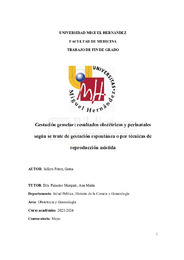Please use this identifier to cite or link to this item:
https://hdl.handle.net/11000/33755Gestación gemelar: resultados obstétricos y perinatales según se trate de gestación espontánea o por técnicas de reproducción asistida
| Title: Gestación gemelar: resultados obstétricos y perinatales según se trate de gestación espontánea o por técnicas de reproducción asistida |
| Authors: Sellers Pérez, Gema |
| Tutor: Palacios Marqués, Ana María |
| Editor: Universidad Miguel Hernández |
| Department: Departamentos de la UMH::Salud Pública, Historia de la Ciencia y Ginecología |
| Issue Date: 2024-04-28 |
| URI: https://hdl.handle.net/11000/33755 |
| Abstract: OBJETIVO: Establecer el riesgo de complicaciones obstétricas (estados hipertensivos del embarazo, diabetes gestacional, parto pretérmino, inducción del parto y parto por cesárea) en las gestaciones gemelares bicoriales en función de si se trata de gestaciones espontáneas o gestaciones conseguidas mediante TRA. MATERIAL Y MÉTODOS: Estudio observacional, descriptivo y transversal que incluye las gestaciones gemelares bicoriales biamnióticas en el Hospital General Universitario Dr. Balmis (HGUDB) entre el uno de enero de 2018 y el 31 de diciembre de 2023. Se estudiaron variables explicativas: edad, índice de masa corporal y tipo de concepción, variables resultado obstétrico: Enfermedad Hipertensiva del Embarazo (EHE), diabetes gestacional (DG), parto pretérmino (PP), inducción al parto, tipo de parto, episiotomía y desgarros III y IV y variables resultado perinatal: sexo, peso, Apgar a los 5’, pH arteria umbilical. Para el análisis estadístico, se utilizó el programa R. Se realizó un análisis bivariante entre las variables a estudio y el método de concepción. Se calculó la Razón de Prevalencia (RP) y la RP ajustada (aRP), y su intervalo de confianza al 95%, de las complicaciones obstétricas mediante la regresión de Poisson con varianza robusta. RESULTADOS: 208 pacientes fueron incluidas en el estudio; de las cuales 114 (54,81%) fueron concebidos de manera espontánea, y 94 (45,19%) fueron concebidos mediante TRA (FIV, FIV-Ovodonación, FIV-ISCI). La proporción media de gestaciones gemelares en nuestro estudio fue de 2,71%, superior a la media española que se sitúa en el 2,14%. Las mujeres del grupo de gestación gemelar mediante técnicas de reproducción asistida (GG-TRA) fueron de mayor edad [37 vs 32 p<0.05] y en nulíparas en mayor proporción [86,3% vs 54,8% p<0.05] que el grupo de gestaciones gemelares espontáneas (GG-E). Sólo la complicación episiotomía fue significativamente mayor en el grupo de GG-TRA (68,9% vs 44,2%, p= 0023) pero tras realizar el ajuste perdió la significatividad. No se encontraron diferencias en los resultados perinatales. CONCLUSIONES: Casi la mitad de las gestaciones gemelares en nuestro estudio fueron concebidas mediante Técnicas de Reproducción Asistida (TRA). En el grupo de las TRA las mujeres fueron en mayor proporción nulíparas y de mayor edad. No se encontraron diferencias estadísticamente significativas en las complicaciones obstétricas y los resultados perinatales estudiadas según el método de concepción. OBJECTIVE: To establish the obstetric risks (hypertensive pregnancy states, gestational diabetes, preterm delivery, labor induction and cesarean delivery) in dichorionic twin pregnancies according to whether they are spontaneous or ART pregnancies MATERIAL AND METHODS: Observational, descriptive, and cross-sectional study including dichorionic biamniotic twin pregnancies at the Hospital General Universitario Dr. Balmis (HGUDB) between January 1, 2018, and December 31, 2023. We studied explanatory variables (age, BMI and the conception method) and other variables such as obstetric outcomes: Hypertensive disorders of pregnancy (HDP), Gestational Diabetes (DG), preterm delivery (PP), labor induction, delivery, episiotomy and III and IV tears; and perinatal outcomes: sex, weight, Apgar test at 5’ and umbilical artery pH. For the statistical analysis, R software was used. A bivariant analysis was performed between the variables under study and the conception method. Prevalence Ratio (PR), adjusted PR (aPR) and their confidence interval at 95% were calculated for obstetric outcomes using Poisson regression with robust variance. RESULTS: 208 patients were included in the study; 114 of them (54.81%) had pregnancies conceived naturally, and 94 (45.19%) had pregnancies conceived through ART (IVF, Ovodonation-IVF, ISCI-IVF). The average twin pregnancies proportion in our study was 2.71%, higher than the Spanish average, which is 2.14%. Women in the assisted reproductive techniques (GG-TRA) group were older [37 vs 34 years p<0.05] and nulliparous [86.3% vs 54.8% p<0.05] in a larger proportion compared to the spontaneous (GG-E) group. Only episiotomy was significantly higher in the GG-TRA group [68.9% vs 44.2%, p = 0.023] but after adjustments lost its statistical significance. No perinatal outcomes differences were found. CONCLUSIONS: Nearly half of the twin pregnancies in our study were conceived by Assisted Reproductive Technologies (ART). In the ART group, women were more often nulliparous and older. No statistically significant differences were found in the obstetric and perinatal outcomes studied according to the conception method. |
| Keywords/Subjects: Gestación gemelar técnicas de reproducción asistida complicaciones obstétricas complicaciones perinatales |
| Knowledge area: CDU: Ciencias aplicadas: Medicina |
| Type of document: info:eu-repo/semantics/bachelorThesis |
| Access rights: info:eu-repo/semantics/openAccess Attribution-NonCommercial-NoDerivatives 4.0 Internacional |
| Appears in Collections: TFG- Medicina |
.png)

